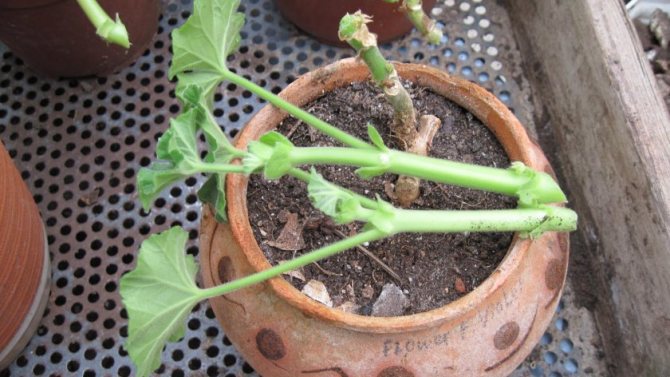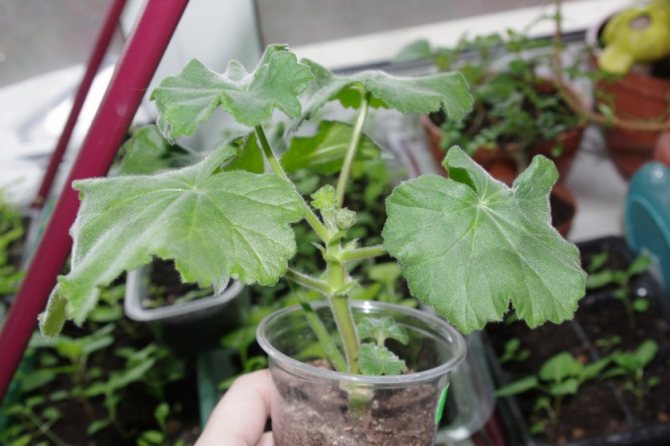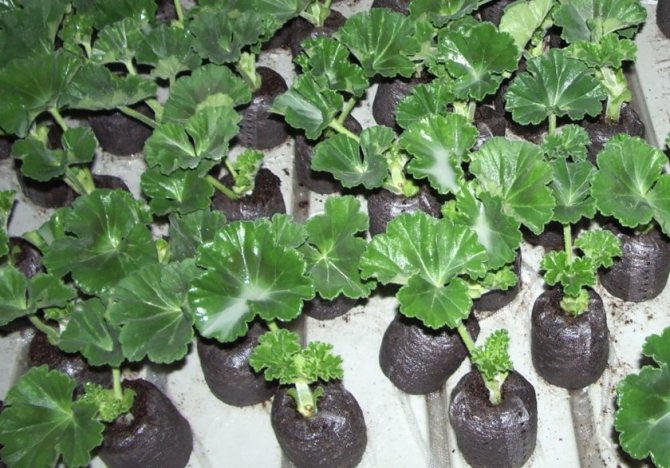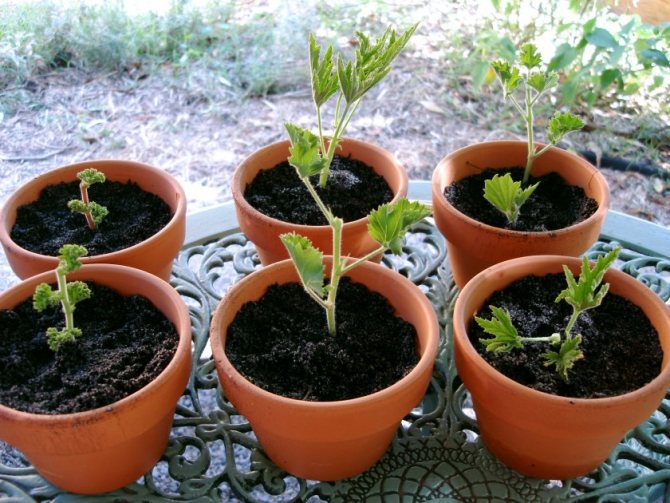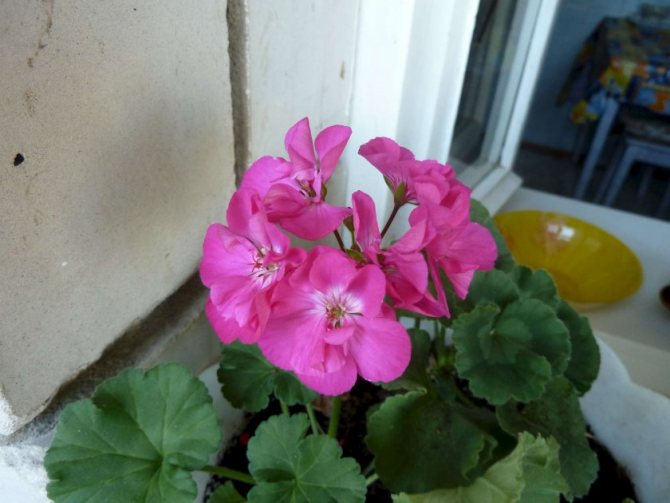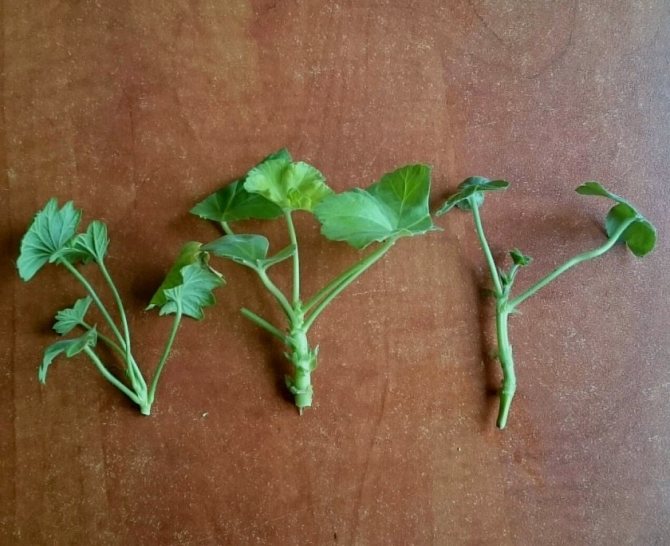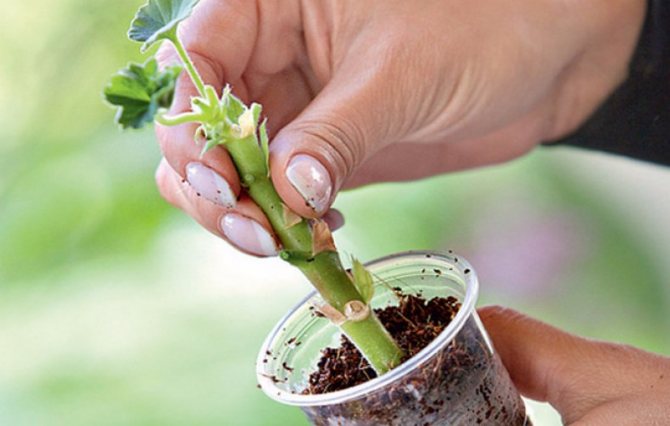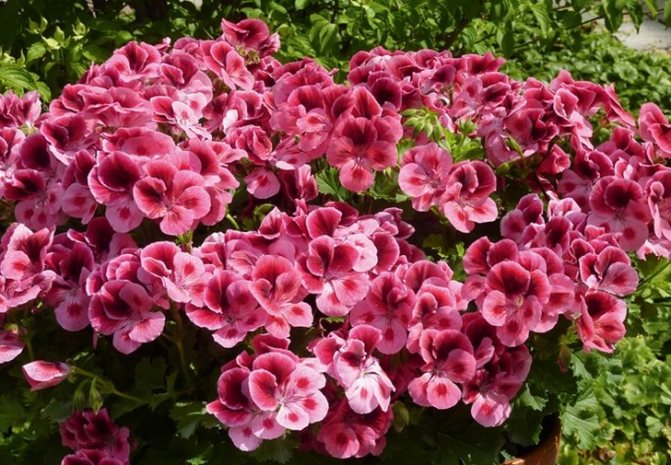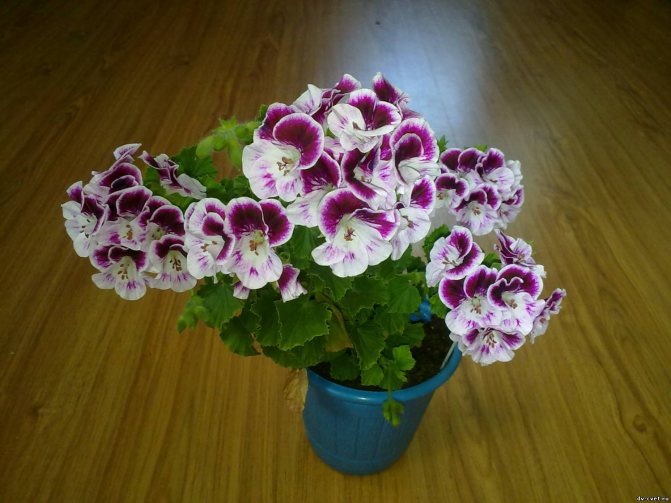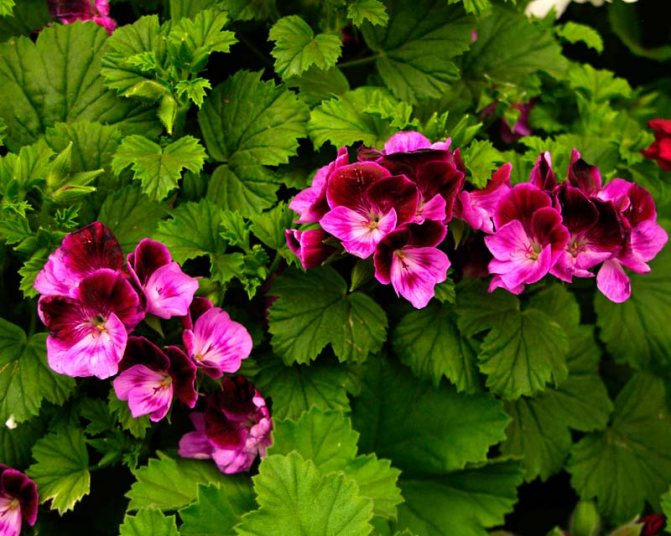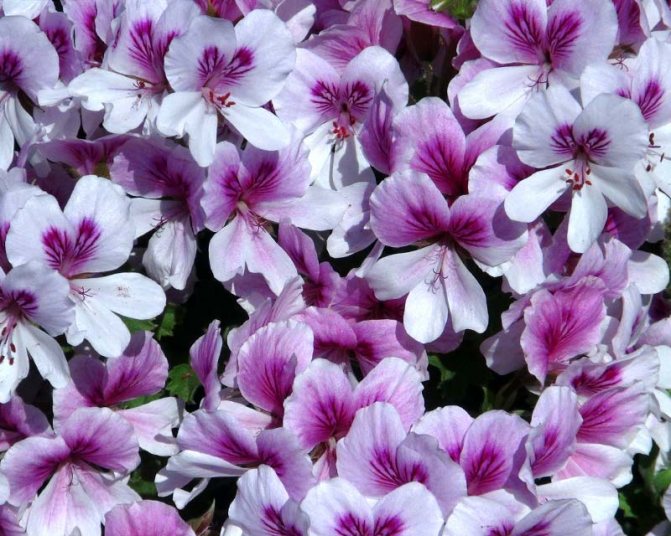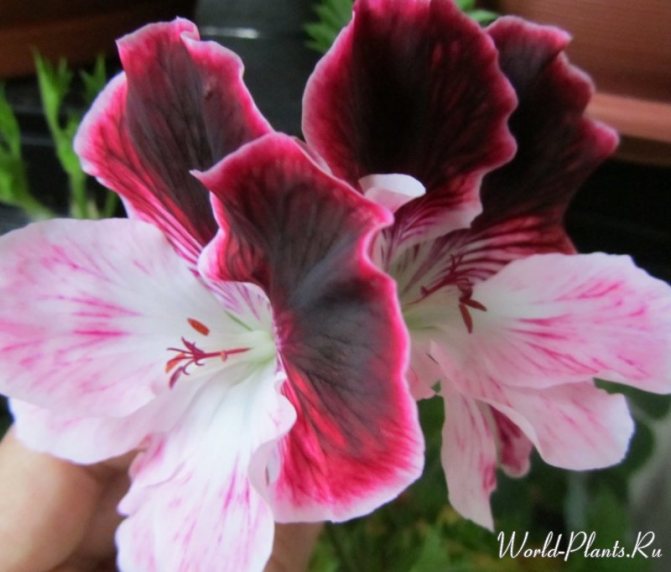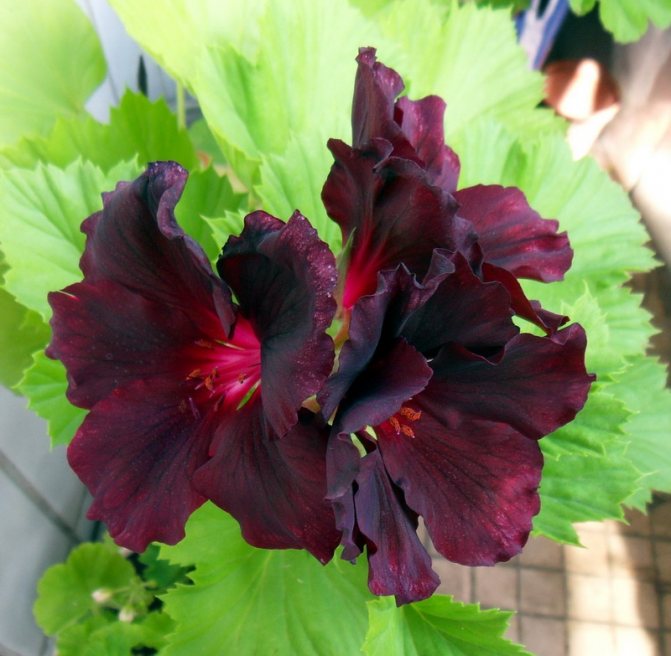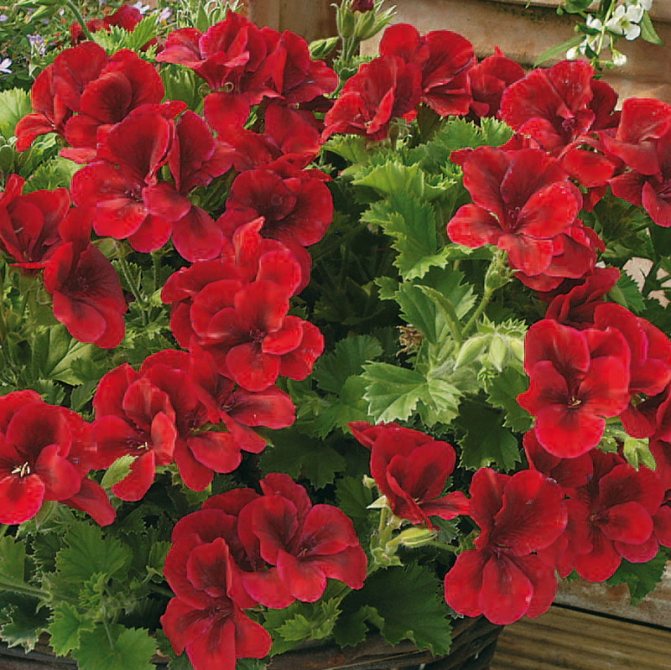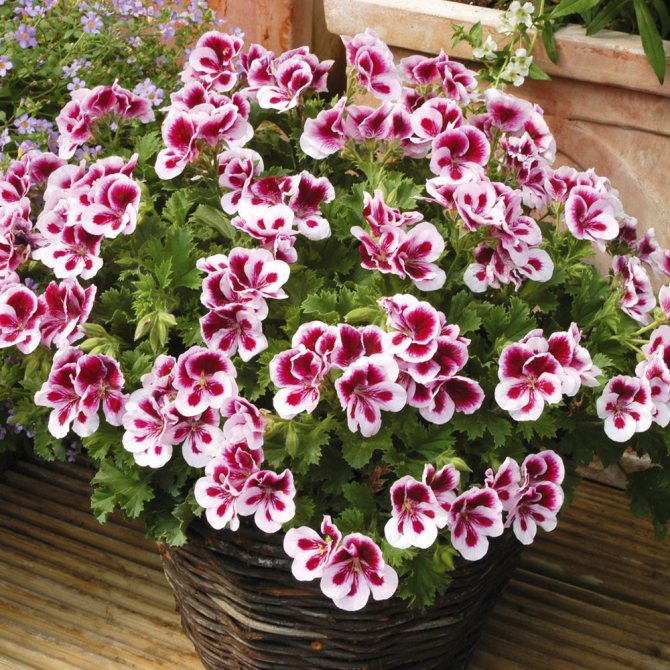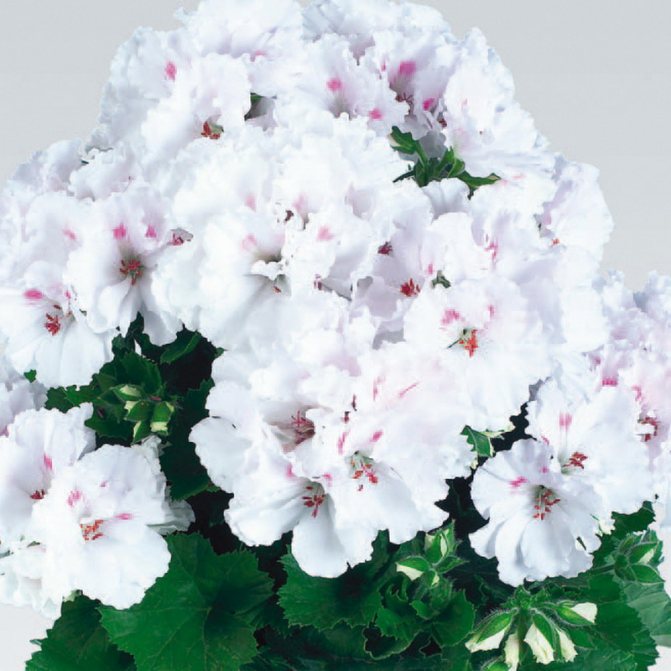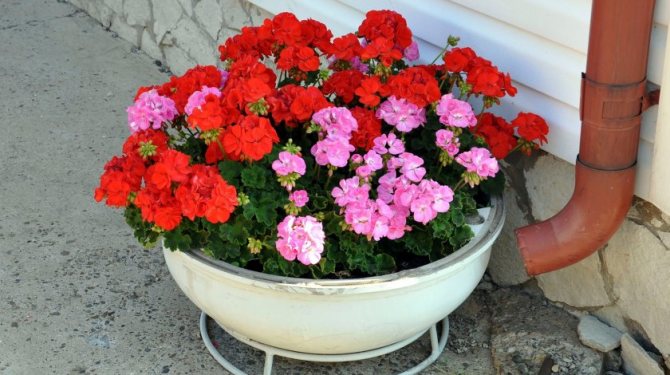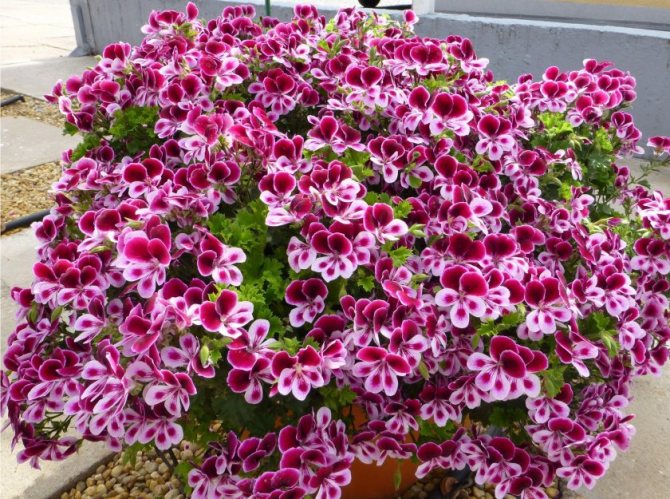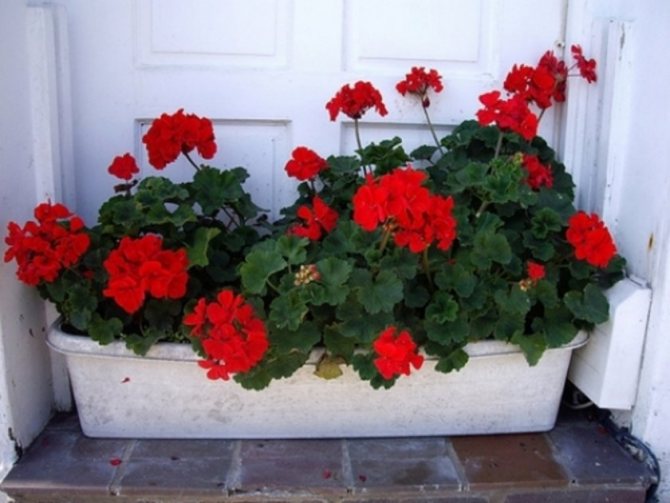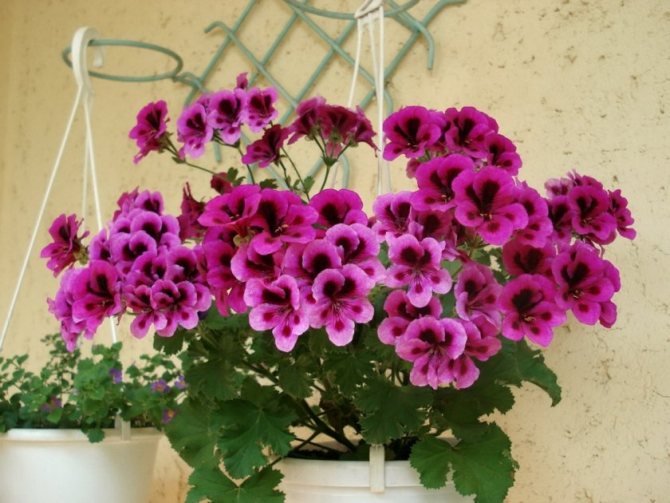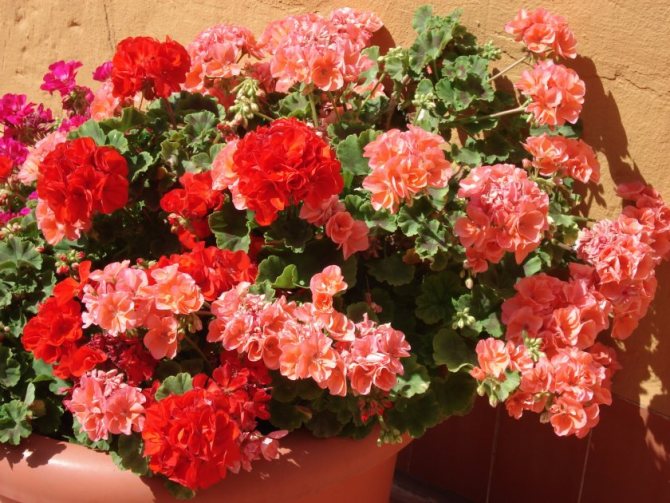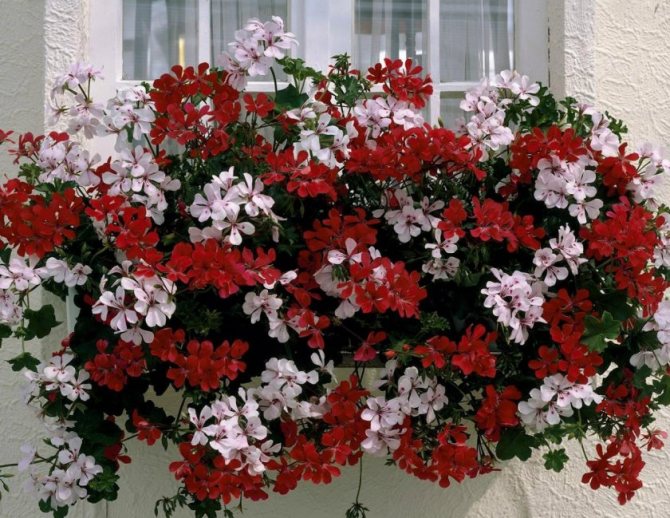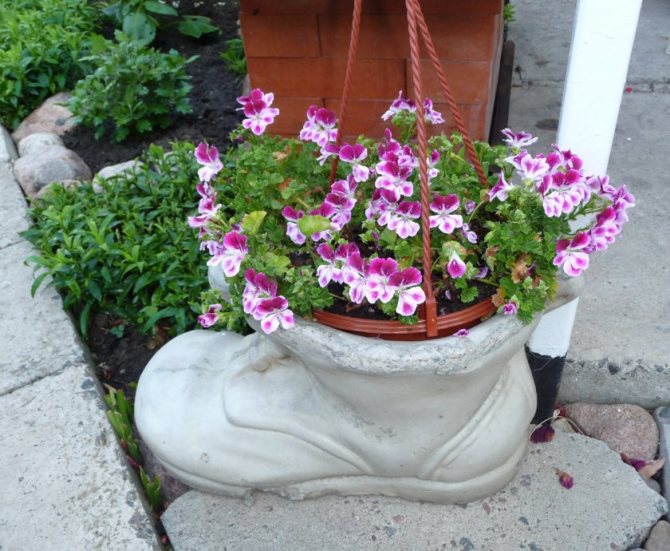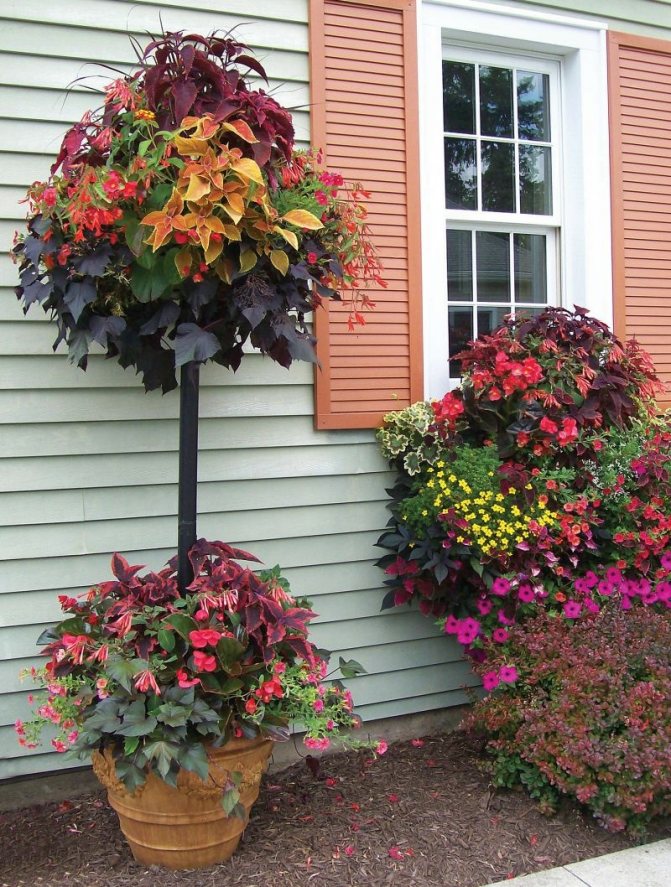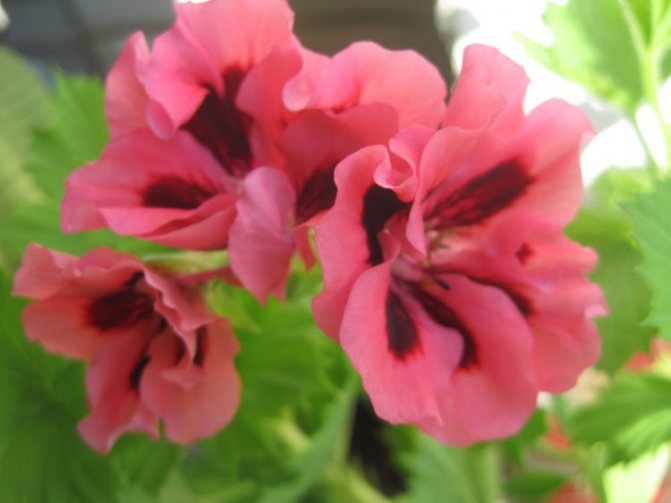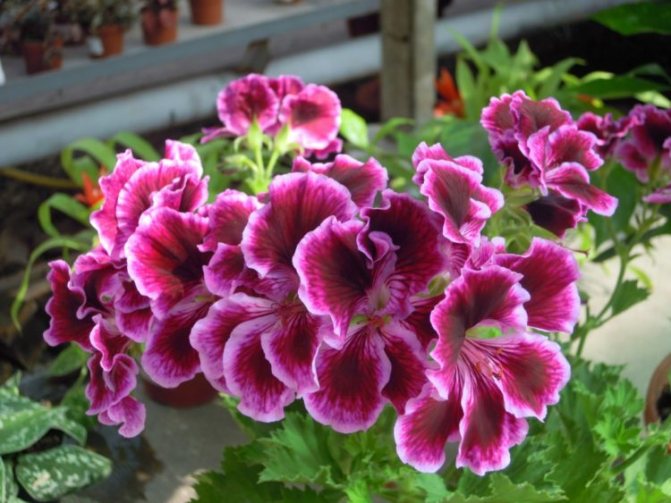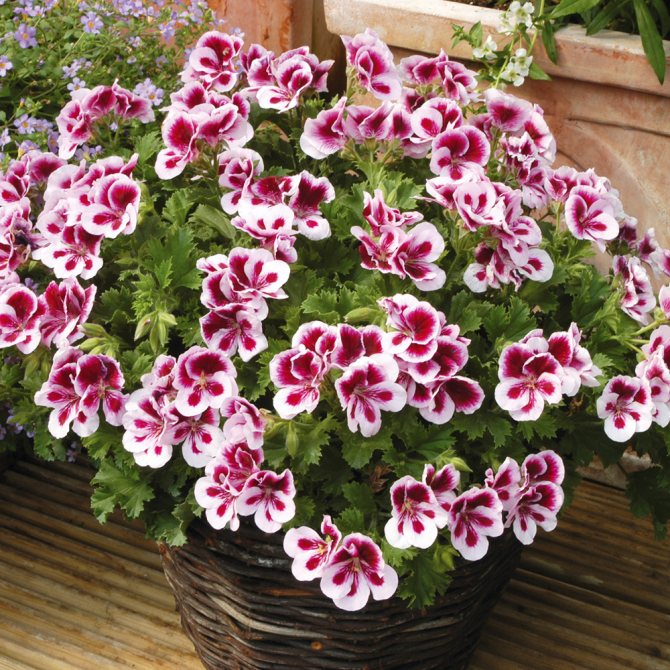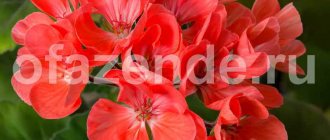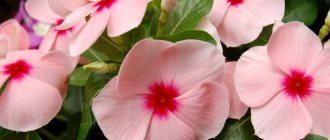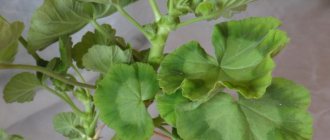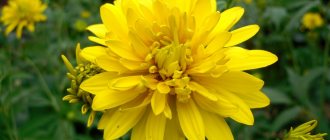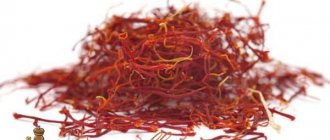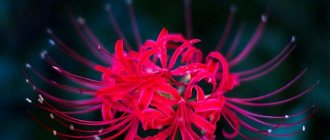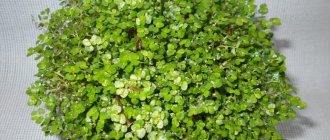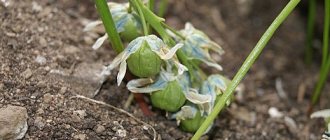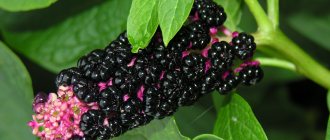In ordinary life, such a flower is often called geranium, only this is an unusual geranium - royal. A characteristic feature of a simple geranium is the presence of a large cap of flowers of various colors.
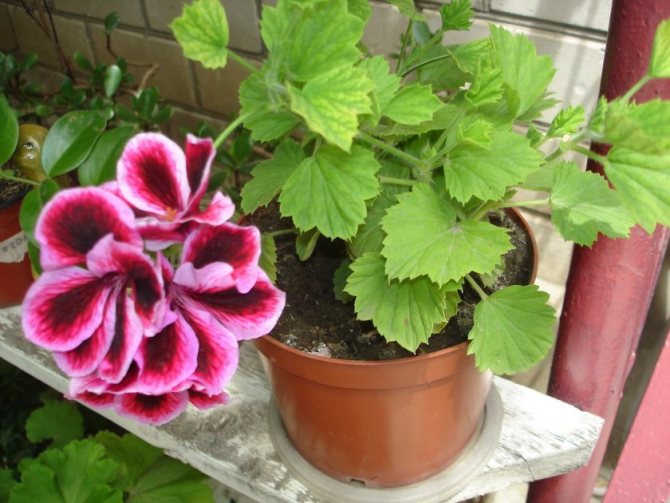
The flower is similar to pansies, since in the middle dark blotches are clearly visible along with light petals, but the leaves themselves are no different from ordinary geraniums.
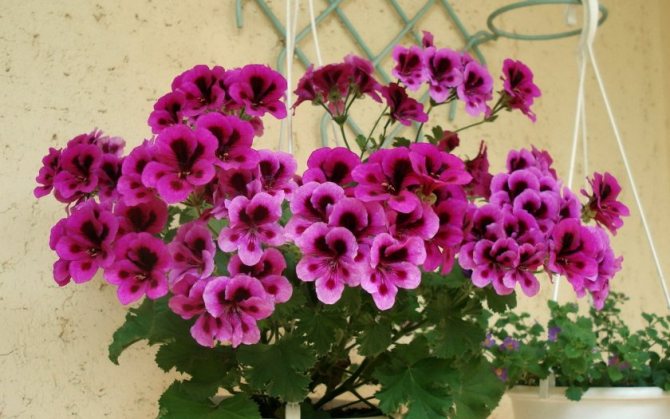

Royal pelargonium blooms from the very beginning of spring to late autumn, a houseplant, thermophilic. The flower does not need special care, here it is only important to water it once a week.
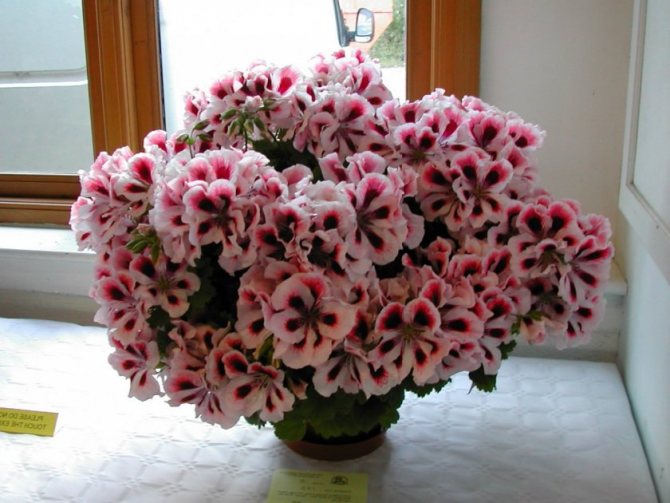

The plant propagates by cuttings. There are quite a few varieties of this plant, each of them has a unique color, leaf size, flower shape.
Description of royal geranium
Tsar Pelargonium is considered one of the most beautiful flower hybrids. The Cape region, located in the southwest of Africa, is considered the homeland. The height of the bush does not exceed 50 cm, while the flowers are located at the foliage level.
The inflorescences can reach 15 cm in diameter. The color varies from white to dark, similar to black. Basically there is a palette of scarlet shades. The petals are arranged in two, sometimes in three rows. The upper one has a bright saturated shade, often with a spotted pattern or veins. Outwardly similar to pansies.
The leaves are dense, velvety, with wavy edges, sometimes in a small denticle. Arranged on the cuttings alternately. The color is green. The stem is straight, latent. The root system consists of adventitious roots.
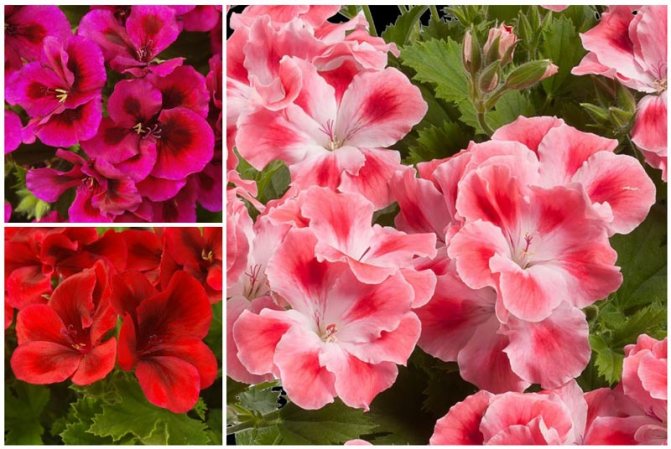

Candy flowers
Why does the culture only produce foliage and not pick up buds?
There are several main reasons:
- The bush is not getting enough nutrients.
- Too large a pot was chosen for planting. The plant "fattens", gaining green mass.
- Damage to the root system. Excessive watering, and as a result, dampness can provoke the appearance of root rot. It is extremely difficult to cope with this disease, therefore experienced flower growers are advised to destroy infected plants in order to avoid contamination of other indoor flowers. The roots can also be damaged mechanically.
- Potential damage by pests (whitefly, aphids and spider mites). For the fight, you can purchase ready-made products in a specialized store.
- The correct rest regime is not observed. If the plant hibernates in a warm room with humid air, most likely it will not bloom.
- It is important to place the plant pot on a sunny side, avoiding direct midday rays.
Varieties and types of royal geranium
More than a thousand varieties have been bred by scientists from Germany. The most common among flower growers are two types: Candy Flowers and Angels. Both with lush flowering, easy to care for.
| View | Description | Application | Varieties, inflorescences |
| Candy flowers | Selective hybrid of Pelargonium with the Angels variety. | They are planted in open ground, similar to the parent group (Angels) in terms of growing conditions and maintenance, does not require wintering, blooms even in extreme heat. | Differs in large flowers.
|
| Angels | They do not have a wintering period, they bloom magnificently, but for a short time (one month - August), in some varieties, the foliage has a rich aroma, due to the participation of curly pelargonium in the hybridization of the variety. The trunk storage allows you to give the ampelous appearance to the bush. | Used in breeding Candy Flowers. | Small flowers on a low stem, similar to pansies.
|
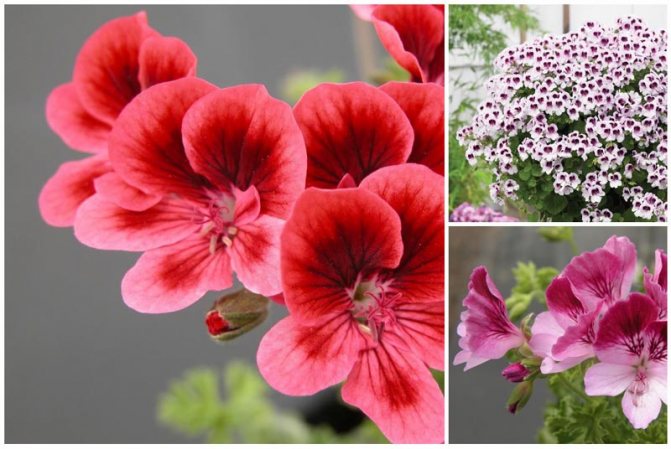

Angels
Winter pruning
Experienced flower growers note that on short winter days, in the absence of sunlight, the royal geranium is pulled up to the height. Pruning for lush flowering at this time is partially replaced by pinching, and the long emerging shoots are cut off.
In April, royal pelargonium begins to bloom, so pruning should be stopped in mid-March. To preserve the shape of the bush, pinching can be carried out in the summer, after flowering. It is strongly not recommended to prune geraniums from December to February, so as not to disturb the dormant period. In winter, the plant rests. At this time, he needs minimal watering and a lighted, cool (temperature not higher than 15 degrees) place.
Unusual varieties of royal geranium
Among the hybrids, scientists managed to get varieties with an unusual structure, bright colorful flowers.
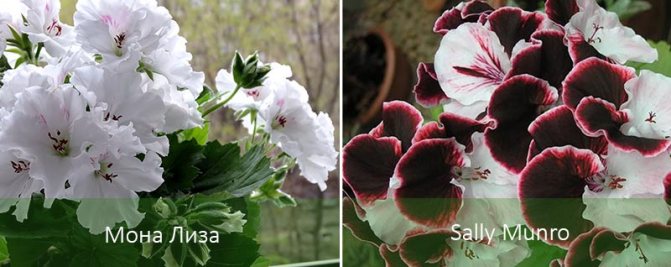

| Variety | Flowers | Features of the |
| Sally munro | The top is deep red, the bottom is pale pink. | Bloom several times per season. |
| Mona lisa | White. | It stands out for its lush flowering among varieties with snow-colored flowers. |
| Georgina Blythe | Orange with a scarlet tint, whitish wavy edges and middle. | Does not exceed 35 cm in height. |
| Morwenna | Intense maroon shade. | The tone is close to black. |
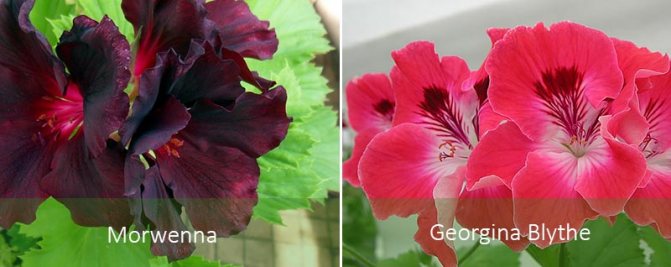

Trim order
In order for pelargonium to delight you with lush flowering, a certain order should be followed:
- removal of wilted stems and faded inflorescences;
- removal of dried leaves and those that are prone to wilting;
- inspect the plant and determine which shoots should be pruned to form a beautiful crown;
- remove the bare and long stems completely (at the lower node);
- in geraniums preparing for wintering, a third of the main stem should be cut off.
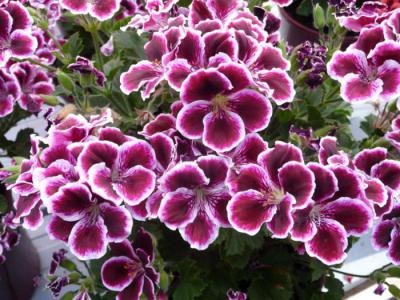

The main rules of home care
Royal geraniums at home require special care. A florist should make an effort so that the flower grows and blooms.
| Factor | Conditions | |
| Spring Summer | Winter | |
| Location | Arranged on a windowsill on the sunny side. | They are placed in a cool place, away from heating appliances. |
| Temperature | + 20 ... + 25 ° C | + 17 ... + 19 ° C |
| Lighting | Avoid direct sunlight. In this case, the plant is shaded. | Phytolamps are used for additional light. |
| Humidity | Increased, depends on the temperature of the room. Spraying can be applied in dry air, but not overspray. | |
| Pot | Choose narrow and shallow. King geraniums love crowding and do not tolerate frequent transplants. Material - unglazed ceramic. | |
| Watering | Twice a day, 50 ml / time per plant, through a pallet. The water is defended, kept in the same room as the flower, so that its temperature corresponds to room temperature. Use boiled, rain-fed. Do not spray. | Cut, watered once a day when the top layer of the earthen coma dries. |
| Top dressing | Mineral 1 time / week, 2-3 months before flowering, they begin to add fertilizers, including phosphorus and potassium. For the young, special complexes are used. It is not recommended to resort to organics. | Doesn't need additional feeding. |
| Pruning | Do not carry out. | Carried out after the end of flowering, in autumn, in two stages, the interval between them is 45-50 days. |
Plant feeding
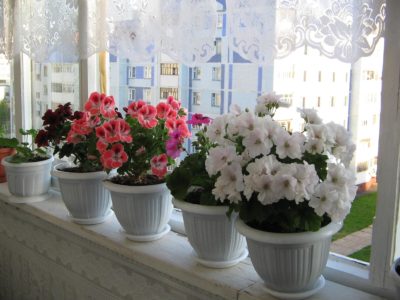

The flower needs abundant watering, but besides watering it is important to feed "Kalachik". How can you feed a plant so that it will delight you with flowers? For abundant flowering in the garden, geraniums are watered with fermented mullein.
On the balcony and windowsill to stimulate flowering, the plant is watered with water with the addition of iodine. In one liter of water, dissolve one drop of iodine and water the plant with 50 grams of iodine water, along the walls of the pots. Before iodine feeding, the flower is watered abundantly so as not to burn the roots. This procedure is carried out once a month.
Other products purchased at the pharmacy can be used as fertilizer for geraniums. In addition to iodine, flower growers use vitamins B1, B6, B12. This is an inexpensive folk method.
With the beginning of spring, geraniums need nitrogen. By summer, vitamins are used - one ampoule per 2 liters of warm water. The earth is watered abundantly with solution. After 3 weeks, vitamins are changed. Such fertilization will help the royal geranium, but you cannot overdo it with feeding, this can destroy the plant.
Organic fertilizers should be used with care. For a lush color, watered with well-fermented cow manure (for 10 liters of water - 1 liter of manure), bird droppings (for 20 liters - 1 liter). Fresh manure can kill the plant.
When choosing from mullein and chicken droppings, it is best to use the first option. For lush flowering, minerals are needed, so organics are rarely used.
Features of summer home care
Pelargonium blooms in the summer. The flower only needs watering and feeding. If it is in the fresh air, then carefully monitor the temperature regime. At rates below + 22 ... + 24 ° C, watering is reduced, below +10 ° C, regularly check the uniformity of drying of the earthen clod. Excessive moisture can lead to root rot and mold growth. Watering is recommended early in the morning before the onset of heat or in the evening, when the sun no longer bakes and goes into the sunset.
For feeding, fertilizers are used with a minimal or no nitrogen content.
On the street, pelargonium is constantly checked for pests. If they are detected, they are immediately treated with an insecticide so that the plant does not get sick and does not die. When choosing a location, avoid direct light exposure.
The sun's rays can leave burn marks on the foliage or it will change color to scarlet. Royal geranium does not tolerate a change of place, therefore it is advised not to plant it in open ground or to do it together with a pot to preserve the rhizome from insect attacks.
Features of the
The plant does not bloom for long: if an ordinary geranium finishes blooming in the fall, then the royal one stops this process in the second half of July. Rarely, when inflorescences last until August. Thus, the owner of the plant can admire its flowering only a few months a year - from three to five at best. And that is why it is so important to achieve the longest possible flowering of geraniums, to make it so that it delights the eye with its decorative effect longer.
To ensure long-term flowering, it is important to keep the plant in conditions suitable for it.
The main thing is a rather cool temperature (about +15 degrees) and high-quality lighting. Next, we will talk about all the points of care in more detail.
Landing of the royal beauty
Frequent transplants for Royal Geraniums are a source of stress, so they are carried out only after the root system completely fills the space in the pot.
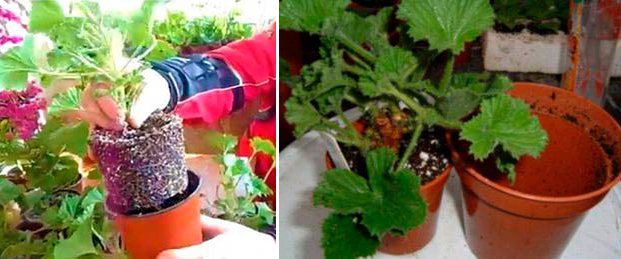

The optimal time is late winter - early spring, before flowering. The dishes are chosen in diameter 1.5-2 cm larger.Drainage is laid out on the bottom, on top it is covered with a layer of cotton fabric. This will help retain soil. The substrate can be purchased at the store. Care must be taken to be free of moisture-retaining components. For self-preparation, peat, humus and sand (1: 1: 1) are used. Ash is added to improve the quality and the formation of a slightly alkaline medium. The soil should be nutritious and loose in consistency.
If the flower was purchased in a store, then you must wait until the end of flowering and give time to adapt in a new place. Only then proceed with the transplant.
The process begins with abundant watering, then the plant, along with a damp earthy clod, is placed in a prepared container. The free space is filled with fresh soil.
Photo
Next, you can see a photo of the royal geranium flowers:
Reproduction
Propagated in two ways: cuttings and seeds. The first is simpler, in the second case, flowering will be longer, the root system is developed and strong.
Cuttings
For planting, use the upper shoots 7-10 cm long with 2-3 nodes on each, obtained during spring pruning. Dry them within two hours after cutting.
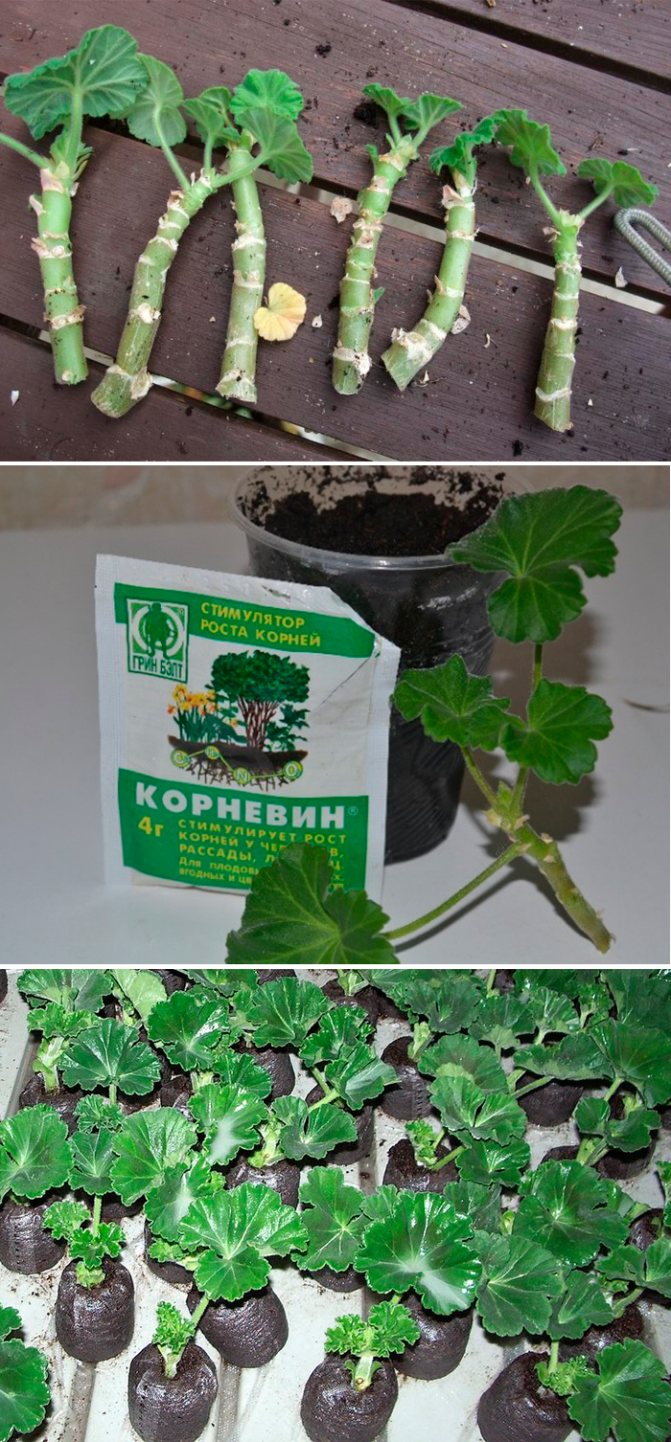

The resulting material is planted in soil, not placed in water, where it can rot and not take root. The soil for disembarkation is prepared in advance. For this:
- prepare a mixture of perlite and earth (1: 1);
- disinfect the resulting substrate in an oven or with a solution of potassium permanganate;
- defend it for two days.
Before planting, the bottom of the shoot is sprinkled with Kornevin's preparation, then it is planted in a prepared dish, buried 2 cm into the soil. Leave in dim light and a temperature of + 14 ... + 16 ° C. Water through a tray so that the roots do not rot from excess moisture.
The planted shoot takes root within a week, then it can be transplanted into a pot. When the shoots are planted in prepared soil, they are not covered with foil, creating a greenhouse effect. To strengthen the rhizome, the emerging leaves are cut off so that the plant does not waste its energy on them.
To simplify the procedure for planting the cutting, a peat tablet is used. In this case, the pallet with them is placed on the windowsill, covered from direct rays of the sun. Scald with boiled water, settled for 3 days, for disinfection, after the moisture has been absorbed, the excess is drained. The stalk is dipped in a root system growth accelerator; this condition is mandatory for Royal Pelargonium. Then the tablets are planted in the center, deepened by one third. The substrate is tightly squeezed to eliminate excess water. A greenhouse is not created, spraying is not carried out, this is contraindicated. After the roots appear, scissors carefully make cuts on the sides and remove the tablet. The places where the roots have grown into it are not touched. The seedlings are placed in plastic cups where they continue to grow.
Seed propagation
Breeding material is purchased at the store. Sow at the end of February, before flowering. The substrate is prepared from peat and sand (1: 1), ash is added. Disinfect by calcining or potassium permanganate solution. The seeds are small, elongated. They are buried in the soil by 5 mm. Seedlings are covered with foil, create a greenhouse effect and removed to a warm place with bright diffused light and a temperature of + 21 ... + 25 ° C.
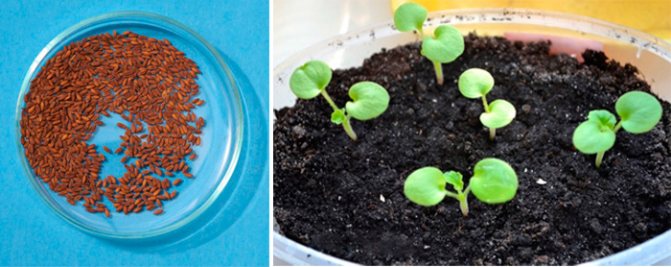

In a month, the first shoots will appear. As soon as they have released two leaves, they are dived into separate pots with a diameter of 10 cm and a depth of 14 cm. A drainage layer is laid on the bottom. After the appearance of 5 leaves, pinching begins to shape and get more side shoots for the splendor of the bush.
Cutting and harvesting cuttings
Cuttings are the main breeding material for geraniums, although breeding with seeds and grafts is also possible. However, the latter methods have not found significant application in most gardeners due to their excessive labor intensity and low productivity.
When to cut
The early autumn period (late August - first third of September) is most suitable for grafting royal pelargonium. During this period, the strongest and healthiest cuttings can be cut, since the pruning is done after the flowering period.
However, many are convinced that the best period for propagation by cuttings is spring. And on the one hand, they are right, since during this period the plant wakes up from hibernation and all life processes are activated in it; but still, you should not do this during this period, since flowering after cutting may well be delayed.
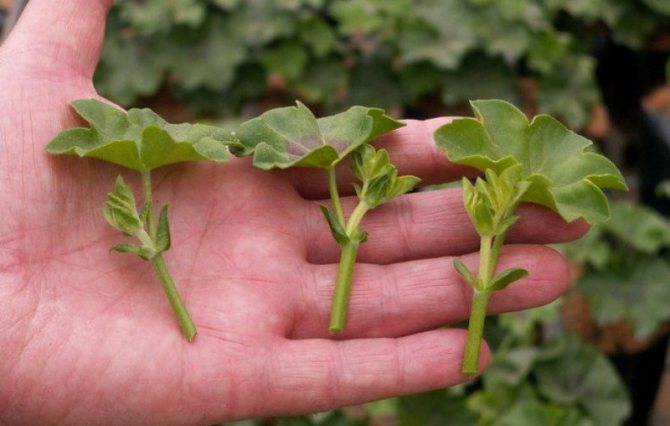

What should be
Propagation of royal pelargonium by cuttings should be carried out using strong and healthy-looking material. The size of the shoot is chosen depending on the length of the mother plant.
How to cut
The young shoot should be separated from the mother stem with a sharp blade or knife just below the node, preferably at a slight angle.
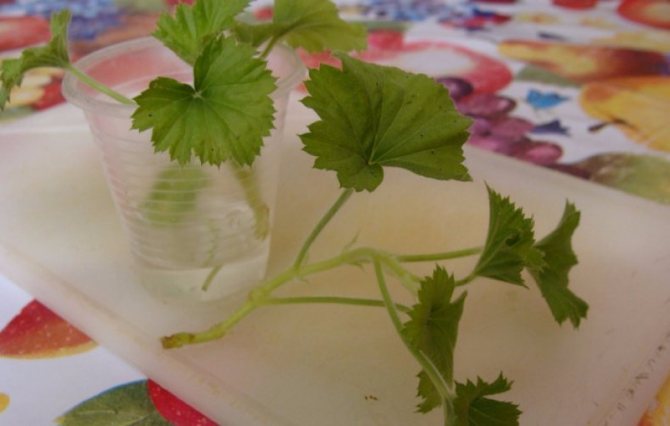

After that, if any, it is worth removing the lower leaves, leaving a few of the upper ones.
If the top leaves are too large, then they should be cut in half. This event is dictated by the fact that the plant will spend too much nutrients and energy to feed the leaves, and they will be very needed for the formation of the root system.
Processing and preparation of cuttings
After cutting off the shoot from the mother plant and cutting off excess leaves, it is necessary to prepare the cuttings for further planting in the ground or introducing them into water.
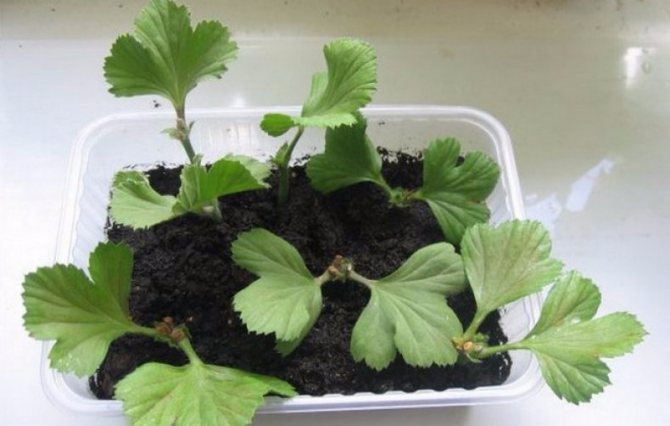

To do this, it is worth lightly treating the cut end of the cutting with charcoal powder and you can immerse it for a few minutes in a phytohormonal solution or a special stimulator for the formation of the root system.
After that, it is necessary to dry the shoots for a short period (2–8 hours, depending on the humidity in the room), and they are ready for the next stage - planting.
Mr. Summer resident warns: possible problems when growing royal geraniums
Large-flowered geranium has its own nuances in care. If you do not follow them, you can face a flower disease, a change in appearance. It will not bloom.
| Problem | Cause | Elimination |
| The trunk rots (black leg disease) | Low temperature, excessive or improper watering. | The plant and soil are affected and must be disposed of. The window sill and the pot must be treated with a chloride substance. |
| Tick, weevils, aphids, whitefly | Infection with parasites. | Wipe the back of the foliage with chamomile infusion and leave for a couple of hours, then rinse. If the broth does not help, apply an insecticide. |
| Lack of flowering | Low temperature conditions, dry air, insufficient lighting, improper pruning, large pot volume, soil is oversaturated with nutrients, nitrogen is present in it, inappropriate fertilizer or lack thereof. | Correct care gaps and create a comfortable environment. |
| The foliage is yellow, falls off, the stem grows, but does not bloom | Little light. | Add light with phytolamps. |
| Green but sluggish, watery pads have formed. | Waterlogging can lead to a disease - gray rot, then the affected foliage is removed, the plant is treated with drugs. | Reduce watering. |
| The ends turn yellow | Lack of moisture. | Increase the amount of moisture supplied. |
| Scarlet shade | Low temperature, drafts. | Move to a warm place with optimal performance. |
How to feed the culture so that it picks up buds?
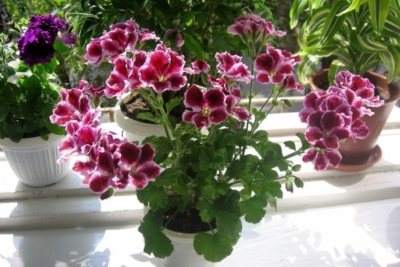

For pelargonium, it is important to receive complex mineral feeding during the flowering period. You need to start fertilizing from the end of February. A solution of mineral fertilizer for flowering plants with a high potassium content should be applied 3-4 times a week. During active flowering, royal geraniums can be fed 2 times a month.
It is not recommended to apply fertilizers during the dormant period of the flower (in winter) and after transplanting.
Pests
- Aphid.
- Ticks.
- Termites.
- Caterpillars.
- Whiteflies.
Different insecticidal preparations are used to control pests.... Aspirin will also help. For this, an aspirin tablet is dissolved in 8 liters of water and the plant is treated with this solution. Such processing must be done every three weeks.
So you got acquainted with the basic rules of caring for royal pelargonium. She is, of course, more finicky in caring than her other relatives, but her luxurious appearance will not leave you indifferent despite the slight difficulties in caring for her.
Royal Pelargonium is a luxurious flower that can attract the attention of anyone. And the desire of the florist to increase the number of copies of this plant in his home is absolutely understandable. Read our materials on how to propagate and why royal pelargonium does not bloom.
Diseases
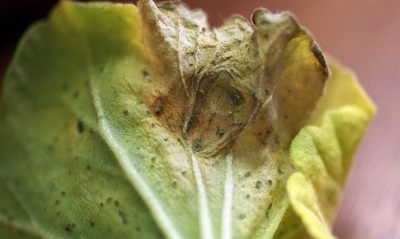

Gray rot - develops due to excess moisture and high nitrogen content in the soil. It manifests itself as brown spots on the leaves and stems, a gray bloom on the flower. For treatment, the plant is transplanted into a new soil and treated with fungicidal agents.- Root and stem rot - the root collar becomes black and begins to rot, the leaves turn pale, turn yellow and wither. The reason is an excess of moisture and low acidity of the soil. To combat rot, use drugs "Biporam", or "Fitolavin".
- Late blight - defeat by a fungus, from which the plant withers and rots. A disease appears due to high humidity. From it, the leaves become pale, and the flower slows down its growth. In places of rot, a white fluff may form. It is necessary to treat the plant with Bordeaux liquid. Damaged parts are removed, the cut sites are treated with charcoal, and the plant is transplanted into new soil.
- Eden - the formation of tubercles and growths on the leaves. It also occurs due to waterlogging. Damaged leaves are trimmed and watering is reduced.
- Verticillary wilting - the most dangerous disease. The infected plant must be destroyed. If the first signs of the disease appear on the shoots, they need to be cut off and the flower treated with biofungicide.
How to store in winter
Most pelargoniums have a dormant period in October, with the arrival of cold weather. No, the plant does not shed its leaves, it simply stops blooming and slows down in growth.
At this time, feeding is stopped, and the flower should be in a room with a temperature of +12 to +15 ⁰C. If necessary, additional lighting is installed so that the stem does not stretch too much.
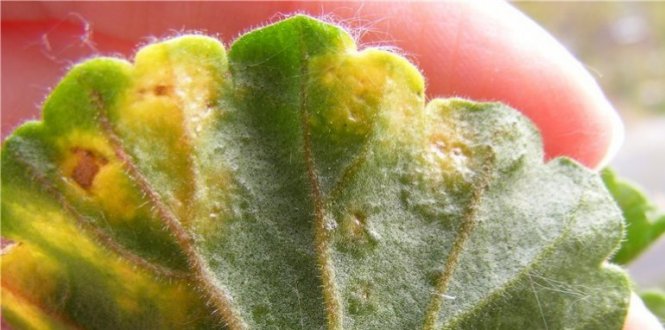

Popular varieties
Consider the popular varieties of royal pelargonium with a photo:
- ‘Mandarin’ has orange flowers. In the middle, the buds are white, along the even edge of the petals there is a white border.
- ‘Candy Flowers Bright Red’ - The plant has cherry-red flowers, with blurry black spots on the petals. This variety branches well and blooms for a long time.
- ‘Regalia Chocolate’ - large dark red flowers with a chocolate tint. The petals have smooth edges and are wide open.
- ‘Carisbrooke’ - the flowers of this variety are light pink. The upper petals have a delicate marble pattern in the form of specks and strokes.
- ‘Lavender Grand Slam’ is a medium-tall plant with mauve flowers. Dark purple feathers are visible on the upper petals.
- ‘White Glory’ - large flowers, more than 7 cm in diameter. They are snow-white in color and do not have a single spot.
- 'Sally Munro' - the variety has large flowers. The upper petals are dark red, while the lower ones are pinkish. This variety is capable of blooming more than once per season.
- 'Candy Flowers Pink with Eye' - flowers of muted pink shades with black specks on the petals.
- ‘Mona Lisa’ - the flowers are large and snow-white. In the middle there are red stamens, and sometimes pink strokes can be seen near them. The petals have wavy edges.
- ‘Black Prince’ is a small bush, up to 40 cm tall. The flowers have a plum hue, and the petals have a silver border.
- ‘Georgina Blythe’ - the small plant has large red flowers with an orange tint. Their neck is white. The petals have wavy edges.
- ‘Morwenna’ is a small cultivar with large, dark red almost black flowers. The petals have lace edges.
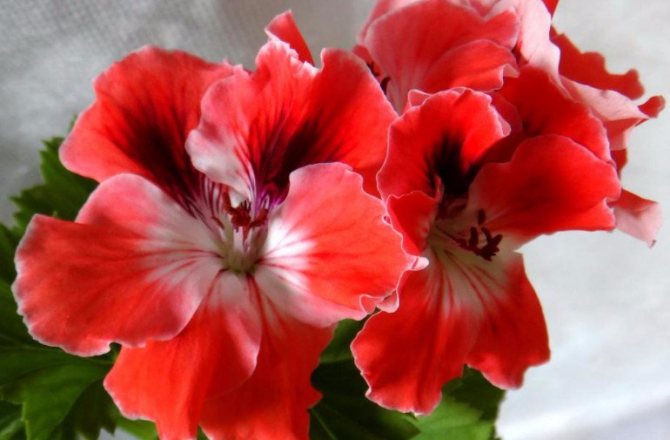

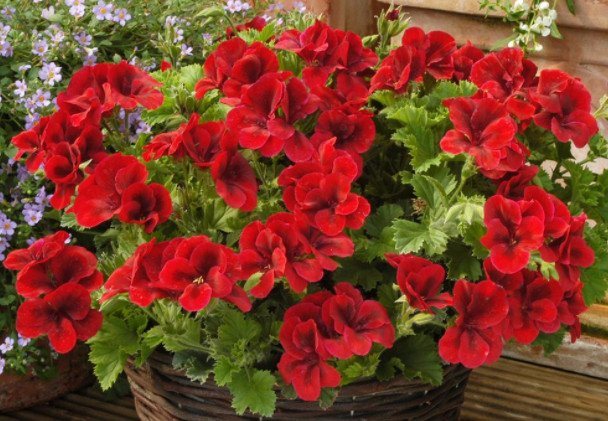

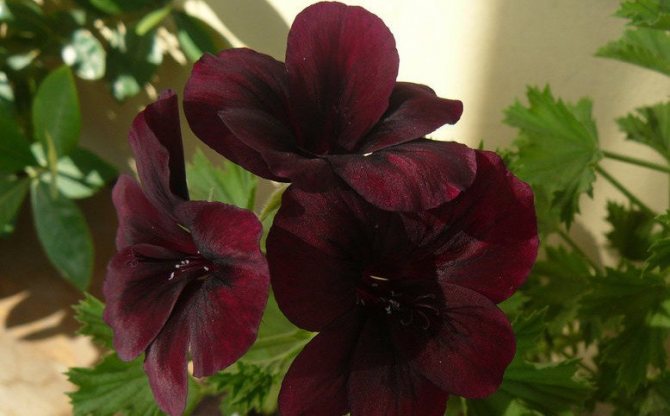

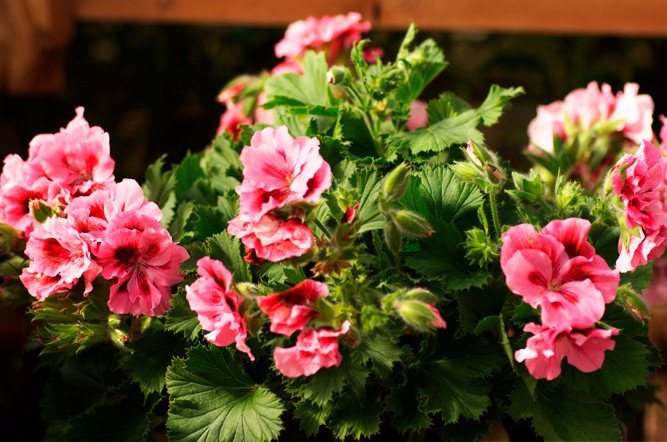

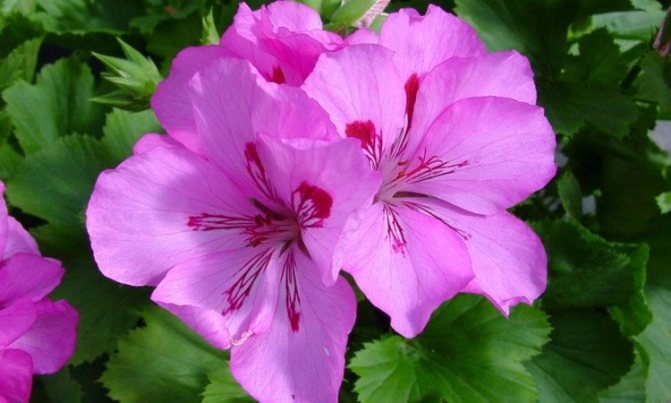

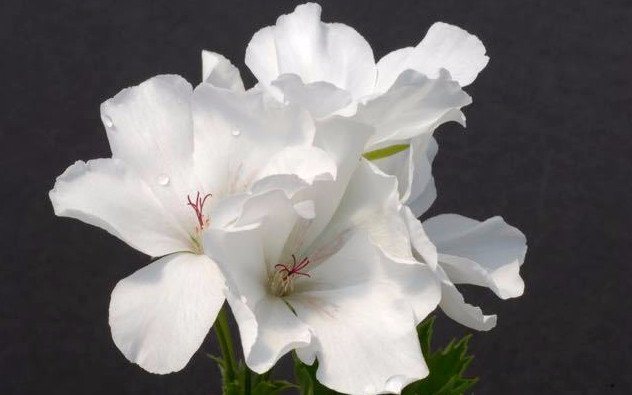

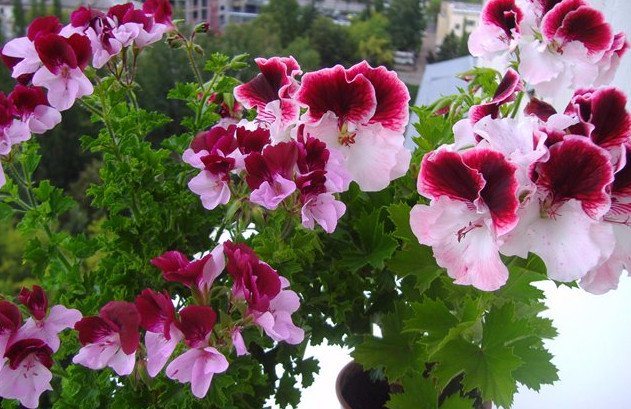

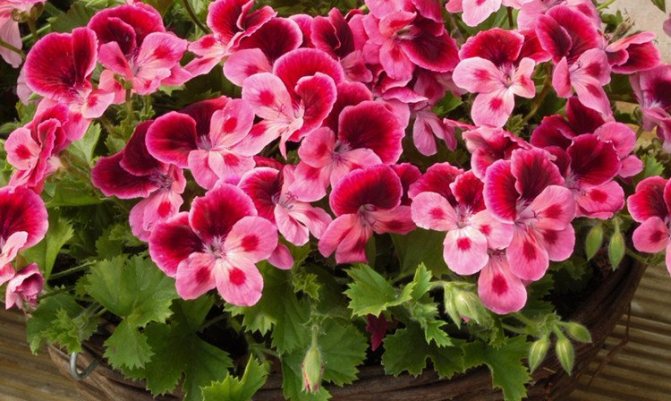

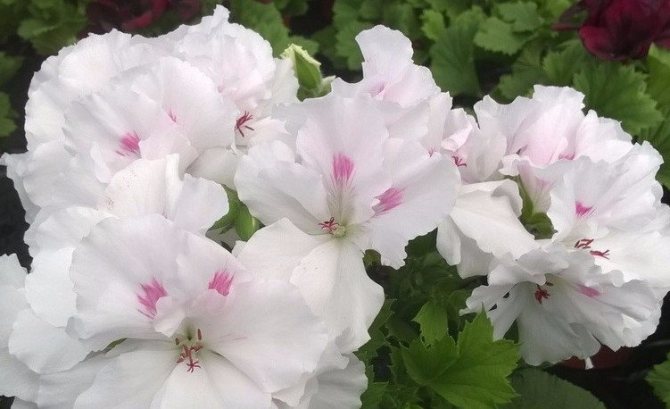

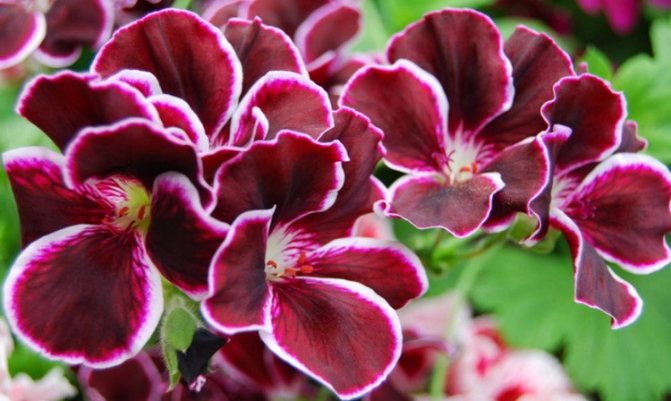

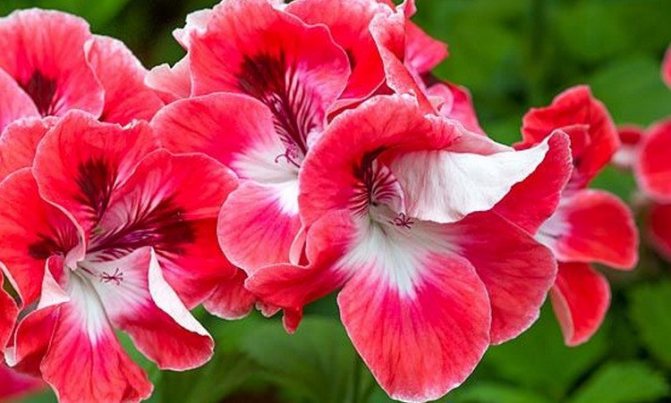

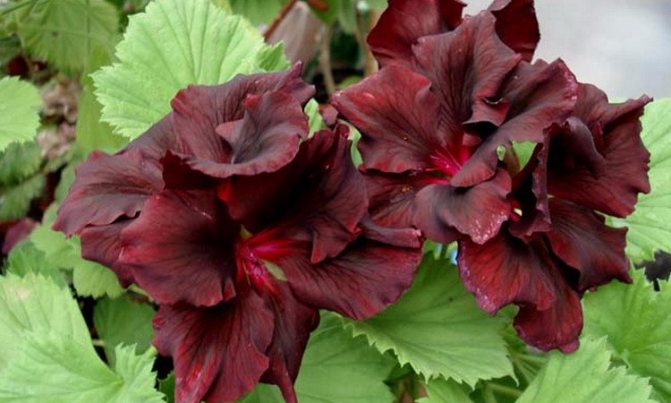

Did you know? Geranium essential oil, which is obtained from the green part of the plant, is a very valuable medicine. It is also used in aromatherapy to calm the psyche and lift the mood.
What if pruning and feeding don't work?
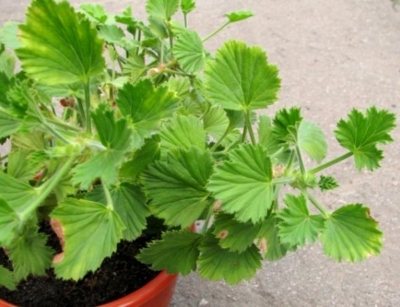

If the conditions of detention are almost ideal, the plant rested over the winter, but there are still no flowers, you can force pelargonium using measures such as:
- During wintering, limit food and watering, keep the plant in cool conditions. In the spring, in a warm room after a Spartan winter, geraniums are likely to bloom.
- Create conditions with a temperature drop, bringing the bush to the balcony, but avoiding freezing and drafts.
- Magnesium sulfate as a top dressing has a beneficial effect on many flowering plants.
- You can try to move the plant around the room, it may be out of place. After the first buds appear, it is better not to touch the pot.
These methods are only suitable for healthy plants. If pests were found on the leaves, and the roots are affected by rot, the fight for lush flowering should begin with the destruction of parasites and the treatment of the flower.
When growing royal geraniums, problems can arise, for example, yellowing of the leaves. Why this happens, how to save a flower, and also about propagation by cuttings - read in our materials.
Main conclusions
Thus, having considered the variety of breeding methods for royal pelargonium, we made sure that everyone can find a suitable one for themselves. Let's remind a few basic recommendations:
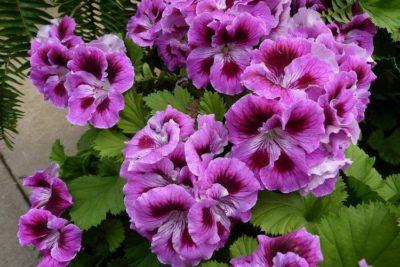

When grafting or dividing from a bush, before planting in a permanent place, it is necessary to achieve the appearance of the first roots. When sowing seeds before burying, it is necessary to damage the hard shell for a faster appearance of the first shoots.- We choose a pot that is small in relation to the plant. We make drainage holes in the bottom.
- An important point is the choice of soil. Royal Pelargonium prefers loose soil, consisting of deoxidized peat, sand and a sufficient amount of mineral fertilizers.
- Please note that not in all cases there is a need to create a greenhouse effect. When rooting cuttings in the ground, do not cover the planting with a glass jar. But when sowing royal pelargonium with seeds, the situation is quite the opposite.
For the accelerated receipt of the first shoots, it is worth covering the tray with a lid or plastic bag. Here you need to periodically ventilate the soil.
Compliance with the conditions for the correct selection of soil, pot and further care will allow you to grow a beautiful flower that will decorate the windowsill of a city apartment or a country house.
If you find an error, please select a piece of text and press Ctrl + Enter.
Characteristics and description of the flower
Until the middle of the 18th century, Europe was unfamiliar with geraniums, however, everything changed when the first samples of this plant were brought from South Africa. It became the basis for breeding new varieties from cuttings.
Along with other species, breeders managed to create pelargonium royal large-flowered, the main decoration of which is their large flowers.
- These plants usually grow as compact shrubs, which are mostly hybrids. When grown at home, they come in the form of small, dense bushes and fragile, highly branching stems.
- Depending on the variety, pelargonium can have different shapes and sizes of leaves.The petioles of geraniums do not differ in length from leaf blades. Many varieties of pelargonium grow round leaves decorated with slightly lobed edges.
- Geranium flowers grow on an elongated, thin stem, which is covered with spherical umbrellas. It often has single, large-sized flowers with bright colors.
- The cultivated variety of pelargonium affects the color of the flowers, which can be white or have any shade of pink and red.
- When grown indoors, you can get fairly low-growing pelargoniums, which do not exceed 25-50 cm in height. The upper part of the leaves is serrated and has a rough texture, and the edges have a sharp wavy shape.
Types and varieties of flowers of royal pelargonium
Flowers are different simple, funnel-shaped, reaching a diameter of 5-8 cm. At the ends of the stems or young branches grow about 10 flowers that look like a cone.
Petals usually have a darker shade in the inner region, often in their front dark lines are formed... With proper plant care, you can enjoy pelargonium flowers from early spring to late summer.
Transfer
Important! You need to transplant a flower in the warm season, that is, in the spring. This is not done every year, but only when the root system grows. You can notice this by the roots that have sprouted through the bottom hole of the pot.
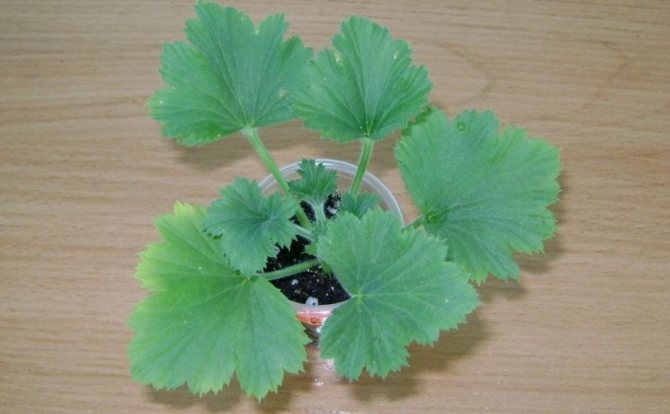

The new container should be slightly larger than the previous pot. Geranium does not like space. During the growing season, fertilizing is necessary, which is carried out once every two weeks.
When transplanting pelargonium, the following recommendations must be observed:
- A drainage layer is laid at the bottom of the pot.
- The soil is purchased in the store or prepared independently. For this, three components are mixed: garden soil, peat and sand in equal proportions.
- Dense soil can destroy geraniums, so it is recommended to first scald the soil with boiling water or hot steam.
How to properly prune pelargonium
Many growers make a huge mistake when pruning geraniums during the active growth period. Such ignorance leads to the fact that the royal geranium does not bloom. Plants are pruned in late August and early September. This procedure is performed in several stages, observing an interval of 1.5 months. Such a period of time avoids the trauma of pelargonium.
Pinching plants encourages the emergence of new shoots. It is carried out after the fifth pair of geranium leaves. The last procedure should be done in the middle of winter. If during the wintering process the plants are very elongated, then they are pruned.
Video "Royal Geranium: Pruning and Care"
Subject to all the rules of care, royal pelargonium will delight with its lush beauty and require increased attention to its person.
What diseases and pests affect pelargonium
Geranium, like other plants, is susceptible to various diseases and parasites. Below we will discuss the most common ones:
| Problem | Signs / solutions |
| Aphid | Infection with parasites is manifested by curling of leaves, whitish shavings and wilting of buds. In order to get rid of pests, it is necessary to treat the underside of the leaves with chamomile infusion or household soap. |
| Whitefly | The appearance of small yellow spots is a symptom of this disease. The pest is an insect 2 mm long. In order to get rid of the whitefly, the plant is washed with a soapy solution of laundry soap. Then, for 30 minutes, the flower is tightly covered with a cellophane bag. |
| Blackleg | The disease occurs as a result of transplanting into a large pot, lowering the temperature and abundant watering. Improper home care can lead to tissue softening and plant loss. |
| Rust | The disease begins with the leaves turning yellow, and over time they dry out and crumble. In order to heal the plant, the affected parts are removed, and the whole plant must be treated with fungicides. |
Houseplant pests and methods of dealing with them
What problems can arise during the operation?
Royal pelargonium is a delicate flower, the following problems may arise during its reproduction:
- The stalk does not take root - the specificity of the geranium variety... There are types of geraniums that do not give roots. If this is the case, try rooting the cutting in the soil. Some pelargoniums take one to two months to take root.
- The stalk is not cut correctly... It should have at least two leaf nodes, or a heel and a leaf node with a kidney.
- Rotted stem... It is necessary to change the water and add activated carbon to it.
- The root growth site is above the water... You need to monitor the water level, you can leave one kidney above it.
- Insufficient soil moisture... The plant should be irrigated on time.
- The stalk is not planted correctly... It must be deepened, leaving a growth point on the surface. After that, the possibility of the appearance of roots will increase.
- Geranium seeds are too deep... It is necessary to sow the seeds again, deepen them into the soil by a maximum of 3-4 mm.
- Poor quality seeds... Buy and sow seeds from another manufacturer or batch.
- Improper care... Seedlings should not be kept under a cover or foil, the soil should be moist and loose, it should not be poured.
- Soil infected with black leg... Before sowing, the soil should be disinfected, the seedlings should be regularly ventilated, and the soil should be sprinkled with ash. When an infection develops, painful plants are removed, the soil is watered with a solution of potassium permanganate, and sprinkled with crushed charcoal.
- Lack of light... Seeds should be sown in March; early sowing requires backlighting. Keep plants on a light window, turn the other side to the window glass every day.
It is recommended to plant new geraniums in disinfected soil, to observe the order of watering.
Features of winter care for large-flowered geraniums
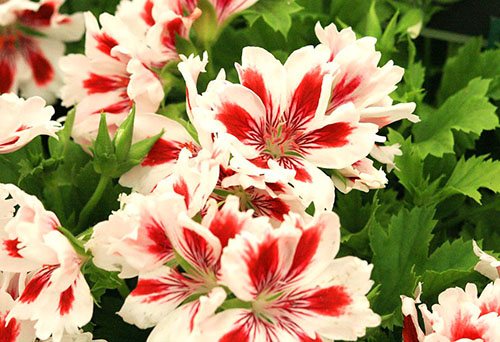

- temperature of the order of 12-15 ° C,
- rare watering, only supporting the decreased activity of pelargonium,
- adequate lighting.
Top dressing for the entire wintering period is stopped. If all the conditions of care are met, the plant lays a sufficient number of flower buds and, when it comes out of the winter torpor, it will surely bloom luxuriously.

